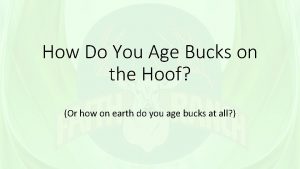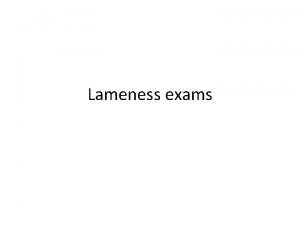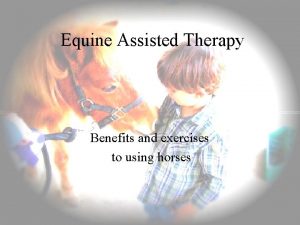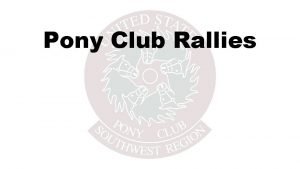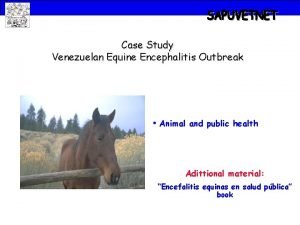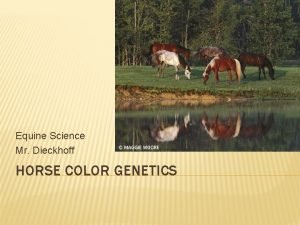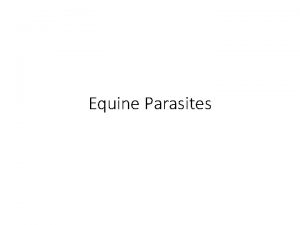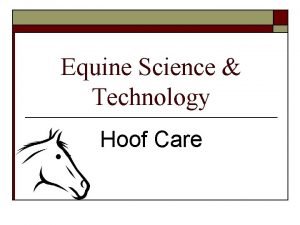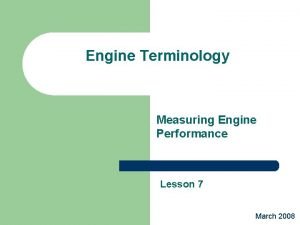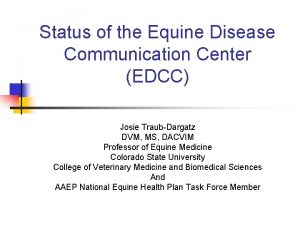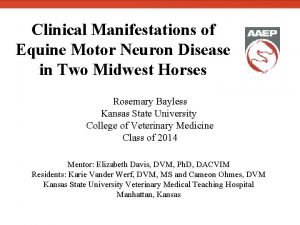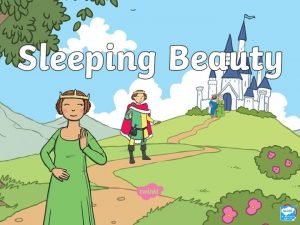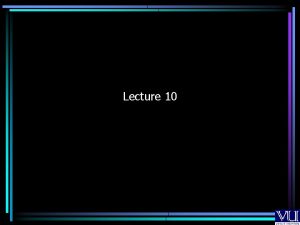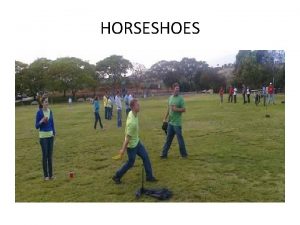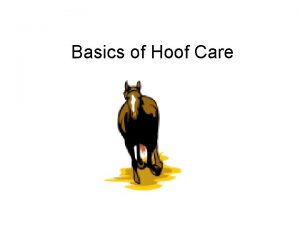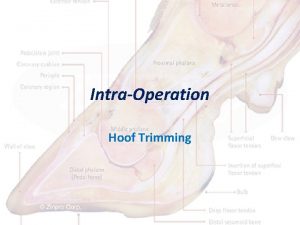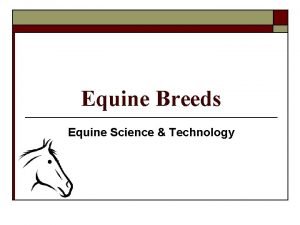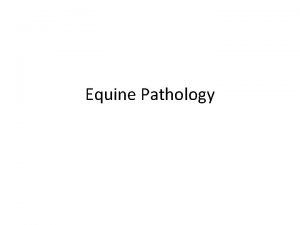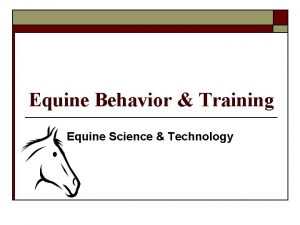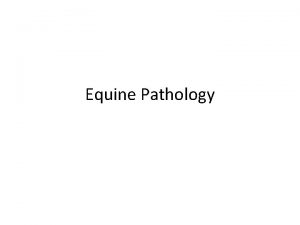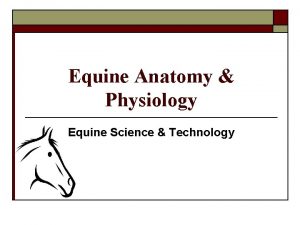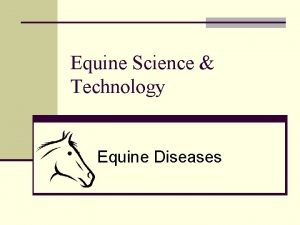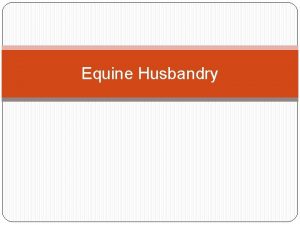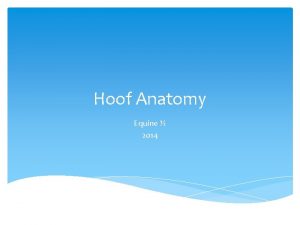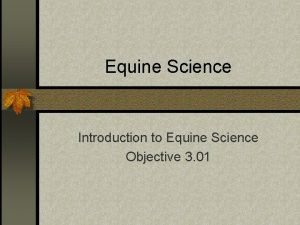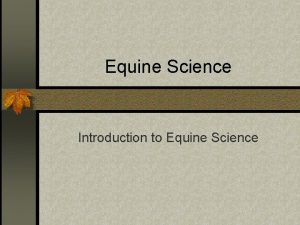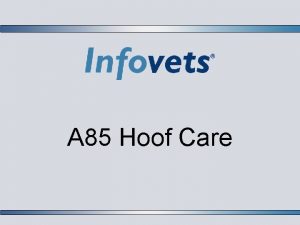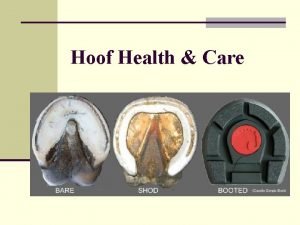Equine Hoof Care Introduction How long have horseshoes






































- Slides: 38

Equine Hoof Care

Introduction • How long have horseshoes been used on horses? – ~ 2, 000 years • Why do we shoe horses? – To protect from excessive wear – Help prevent disease and injury • Neglect may lead to many problems and unsoundness

Hoof Movement • Must be accommodated by: – Trimming – Shoeing • Hoof functions in a: – Non-slipping manner – Cutting into ground as it breaks over

Remember • Hooves are not rigid structures – The move through the flexion of internal structures

Hoof Movement • Are front hooves shaped differently than hind? • Wide front hooves. Why? – Provide lateral stability • Narrow hind hooves. Why? – Allow for maneuverability when making sharp turns • Shoeing improves traction on soft ground

Rate of Growth • Rapidly growing hoofs are usually of higher quality and easier to keep • Many factors effect hoof growth – Young vs. Old – Warm vs. Cold – Irritation vs. Normal – Front vs. Hind – Increased Exercise vs. Idle – Ad Libitum Feeding vs. Limited Intake

Rate of Growth • Also seems to be highly correlated to: – Heart rate • Foals have a heart rate: – At least twice-as-fast as older animals • Rate decreases with age • Average growth rate of hoof is about? – 3/8 inch/month

Rate of Growth • Why may hooves grow uneven? – Unequal weight distribution • May cause flaring or cracks • How often should trimming occur? – Every 4 -6 weeks typically

Hoof Moisture • Does Moisture effect hoof quality? – Absolutely - Directly – Constant evaporation taking place – Too much water • May create weak hooves – Too little water • may cause hooves to become brittle and break off

Hoof Moisture • Water Content of Hoof: – Wall • 25% – Sole • 33% – Frog • 50%

Foot Care Guidelines • Foot problems cause the majority of lameness • What has the greatest effect on pre-disposition to foot disease? – Hoof Conformation – Body Conformation

Foot Care Guidelines • Do all horses need to be shod? – NO – Depends on individual horse’s food health, conformation, and their usage • Shoes provide: – Protection from rocks and debris – Traction

Shoeing • Shoes should be applied with: – Nails in the front half of the foot – Should be long enough to give support to heel • Shoes should provide – Some degree of traction and protection to sole • Clips may also be used to secure shoes • Hot fitting may also increase fit of shoes

Horse Shoes


Common Foot Problems • Foot Disease may cause: – Severe Lameness – May be worse by owner neglect • Diseases may occur even under – Optimum conditions

Common Foot Problems • Thrush: – Destruction of the frog by anaerobic bacteria – Usually black and strong smelling – Commonly found in the sulcus – If severe enough, could lead to an abscess

Common Foot Problems • Thrush: – Usually caused by: • Unclean, dirty conditions • Combined with long untrimmed hooves – Most infections are stopped by: • Removing affected tissue • Cleaning foot daily • Applying antiseptic drying agent

Common Foot Problems • White Line Disease: – A fungal infection of the hoof wall – Wall must be removed and treated with strong fungicide – Common in humid areas

Common Foot Problems • Sole Bruises: – Caused by concussion of the sole – Caused by rocks, gravel, and hard objects – Un-level horseshoe may also cause problem – Once bruised, pads may need to be applied

Common Foot Problems • Abscess: – Pus pocket or infection of sensitive structures – Most commonly occurs in sole or the white line area – Follows the path of least resistance until it breaks out and drains – May result from puncture wounds, thrush, sole bruises, or laminitis – Tetanus vaccinations are important

Common Foot Problems • Abscess: – Must be opened to allow to drain – Soaking in Epsom salt helps promote drainage – Germicide should be applied – Should also be packed to promote drainage – Pads applied – Can cause intense pain and severe lameness

Common Foot Problems • Sand Crack: – Often called a toe crack or quarter crack – May be superficial or deep and serious – May result from: • • • Uneven weight bearing Irregular hoof growth Wire Cuts Excessive hoof length Dry Conditions

Common Foot Problems • Navicular Disease: – Pain in the area of the Navicular Bone – May involve: • • • Inflammation of the Navicular bursa Ligament Sprains Cartilage or Tendon Destruction Bone Changes Pain may be mild or severe

Common Foot Problems • Navicular Bone Function: – Redirects the pull of the deep flexor tendon against the coffin bone as the horse moves forward – The navicular bursa is a fluid-filled sack that lubricates the tendon surface of the navicular bone

Common Foot Problems • Navicular Bone: – Held in place by two ligaments – Ligaments provide blood supply and nourishment – If injury occurs, blood supply may be affected and lameness may occur

Common Foot Problems • Signs of Navicular Disease: – Pointing of toe with heel off the ground – Short Steps – Contracted Heels • Treatment: – Bar shoes with heel support – Medication to improve circulation – Nerve operations (last resort)

Common Foot Problems • Laminitis or Founder: – Disturbance in the circulation of the laminae – Inflammation of laminae • Possible separation • Rotation of coffin bone

Common Foot Problems • Causes of Acute Laminitis: – – – – Over feeding or sudden changes in feeding Colic Excess water consumption when hot Excessive foot concussion or fatigue Retained placenta Infections or poisons Drug abuse Allergies

Common Foot Problems • Signs of Acute Laminitis: – Heat in the foot – Stronger than Normal Digital Pulse – Characteristic Stance

Common Foot Problems • Treatment of Acute Laminitis: – Difficult and often disappointing – Coffin Bone must be stabilized – Abscesses must be drained – Part of hoof wall may need to be removed – May require as much as a year of daily treatment – Many never recover

Common Foot Problems • Treatment of Acute Laminitis : – Heart bar shoes may be applied to provide support – Drugs used to deaden pain & improve circulation – Heel elevation

Common Foot Problems • Chronic Laminitis: – Lingering lameness – Can be detected by: • Irregular rings in hoof wall • Wider at the heel than at the toe – Wide white line at the toe and a flat sole – Good management is the best treatment – Sometimes foot disease is unavoidable

What Happens During Laminitis? • Endotoxemia occurs • Blood concentration lactic acid increases • Histamine formation & blood platelet function impaired • Shunts Open • Necrosis of laminae • Possible rotation of coffin bone

Laminitis or Founder



 3 hoof genres in letterkunde
3 hoof genres in letterkunde Portal boc
Portal boc How to age a buck on the hoof
How to age a buck on the hoof With the order reversed perversely crossword clue
With the order reversed perversely crossword clue Hoof rasp
Hoof rasp Scoring deer on the hoof
Scoring deer on the hoof Yvette van hoof
Yvette van hoof Hoof tester
Hoof tester Sebastian hoof
Sebastian hoof Long and short
Long and short Once upon a time there was a little red fox
Once upon a time there was a little red fox Primary secondary and tertiary care
Primary secondary and tertiary care Exclusively equine vet
Exclusively equine vet Lingfield equine vets
Lingfield equine vets Equine definition
Equine definition Us pony club stall card
Us pony club stall card Equine encephalitis
Equine encephalitis Equine encephalitis
Equine encephalitis Pasture pals equine rescue
Pasture pals equine rescue Equine synonym
Equine synonym Horse color calculator
Horse color calculator Strongylus vulgaris
Strongylus vulgaris Equine
Equine Equine
Equine Equine
Equine Equine science
Equine science Equine science
Equine science Indicated horsepower formula
Indicated horsepower formula Equine disease communication center
Equine disease communication center Rto incompass
Rto incompass Equine motor neuron disease
Equine motor neuron disease 6 faces; 12 edges; 8 vertices
6 faces; 12 edges; 8 vertices Long time ago people
Long time ago people Once there lived a king
Once there lived a king Poem about tinikling
Poem about tinikling Once upon a time and long ago
Once upon a time and long ago Long long int c
Long long int c Long long ago when the gods and goddesses
Long long ago when the gods and goddesses Sóc nhí câu đố
Sóc nhí câu đố


